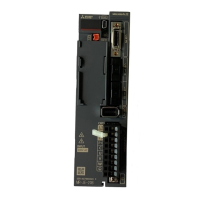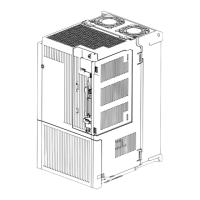1. FUNCTIONS AND CONFIGURATION
1 - 6
Function Description
Control
mode
Detailed
explanation
CP CL
Tough drive function
This function makes the equipment continue operating even under the
condition that an alarm occurs.
The tough drive function includes two types: the vibration tough drive and
the instantaneous power failure tough drive.
MR-JE-_A
Section 7.3
Drive recorder function
This function continuously monitors the servo status and records the status
transition before and after an alarm for a fixed period of time. You can check
the recorded data on the drive recorder window on MR Configurator2 by
clicking the "Graph" button.
However, the drive recorder is not available when:
1. The graph function of MR Configurator2 is being used.
2. The machine analyzer function is being used.
3. [Pr. PF21] is set to "-1".
[Pr. PA23]
Servo amplifier life
diagnosis function
You can check the cumulative energization time and the number of on/off
times of the inrush relay. This function gives an indication of the replacement
time for parts of the servo amplifier including a capacitor and a relay before
they malfunction.
MR Configurator2 is necessary for this function.
Power monitoring function
This function calculates the power running energy and the regenerative
power from the data in the servo amplifier such as speed and current. Power
consumption and others are displayed on MR Configurator2.
Machine diagnosis
function
From the data in the servo amplifier, this function estimates the friction and
vibrational component of the drive system in the equipment and recognizes
an error in the machine parts, including a ball screw and bearing.
MR Configurator2 is necessary for this function.
Lost motion compensation
function
This function improves the response delay occurred when the machine
moving direction is reversed. This is used with servo amplifiers with software
version C5 or later. Check the software version of the servo amplifier using
MR Configurator2.
MR-JE-_A
Section 7.5
Limit switch
Limits travel intervals using LSP (Forward rotation stroke end) and LSN
(Reverse rotation stroke end).
S-pattern
acceleration/deceleration
Enables smooth acceleration and deceleration.
Set S-pattern acceleration/deceleration time constants with [Pr. PC03].
As compared with linear acceleration/deceleration, the
acceleration/deceleration time will be longer for the S-pattern
acceleration/deceleration time constants regardless of command speed.
[Pr. PC03]
Section
5.2.2
Software limit
Limits travel intervals by address using parameters.
Enables the same function with the limit switch by setting parameters.
Section 7.4
Analog override
Limits a servo motor speed with analog inputs.
A value can be changed from 0% to 200% for a set speed.
Section 2.4
Teaching function
After an operation travels to a target position with a JOG operation or
manual pulse generator operation, pushing the SET button of the operation
part or turning on TCH (Teach) will import position data.
Section
3.1.10
Simple cam function
This function enables synchronous control by using software instead of
controlling mechanically with cam. This function enables the encoder
following function, mark sensor input compensation function, synchronous
operation using positioning data, and synchronous interpolation operation.
Section 6.1
Modbus RTU
communication function
The Modbus protocol uses dedicated message frames for the serial
communication between a master and slaves.
Using the functions in the message frames enables to read or write data
from/to parameters, write input commands, and check operation status of
servo amplifiers.
MR-JE-_A
Servo
Amplifier
Instruction
Manual
(Modbus
RTU
Protocol)

